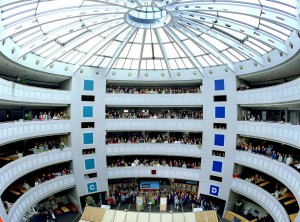
By Krisztina Holly
As a leader, imagine trying to manage more than 7,000 scientists from eighty-five countries around the world—with their own languages, cultures, and expertise—on a twenty-year collaboration to create the most complex system ever built.
Now imagine the goal is to recreate the conditions existing a billionth of a second after the big bang. And none of the experts on your team will get personal credit for changing our fundamental understanding of the universe. And, by the way, you don’t have control of anyone’s paycheck.

Eight torodial magnets can be seen on the huge ATLAS detector with the calorimeter before it is moved into the middle of the detector. This calorimeter will measure the energies of particles produced when protons collide in the center of the detector.
Photo Credit: The ATLAS Experiment at CERN, atlas.ch
It might seem like an impossible management situation. But that is exactly what is going on at the Large Hadron Collider (LHC) at the European Organization for Nuclear Research (CERN) in Geneva, Switzerland.
The LHC has garnered some attention to date: a catastrophic accident delayed the experiments for a year, myths of black holes still plague the program, and the just-released movie Angels and Demons features a fictitious “antimatter bomb” from CERN. But these issues distract us from the real story.
Beyond the atom smashing, leaders have special reason to examine what is going on in Geneva. CERN’s remarkable innovation culture is what makes their extraordinary advancements possible. Most importantly, we all can apply these same lessons to stimulate innovation in our own organizations, no matter how big or how small.
Collective Ownership
The LHC is a wonder to behold: a circular tunnel 27 km in length with four enormous detectors, 100 meters entirely below ground. The detector for one of the four experiments, called ATLAS, weighs as much as the Eiffel Tower, has about 20 million components, uses 3,000 km of cables and 1,000 km of piping, and requires some 5 million lines of computing code to run. The Compact Muon Solenoid (CMS) weighs twice as much, and “although it is the size of a cathedral,” CERN officials explain, “it contains detectors as precise as Swiss watches.”

Technicians mount power distribution cables onto a cylinder that houses nine disks with silicon sensors while assembling an endcap of the ATLAS silicon strip detector.
Photo Credit: The ATLAS Experiment at CERN, atlas.ch
The machine has shattered technological frontiers. The team has put together the largest supercomputer on Earth, which will crunch 15 petabytes of data every year using a grid of 100,000 processors around the world. They have built the world’s most powerful magnets, pushed the limits on communication speeds for radiation-hard electronics, and built a silicon detector twice as large as anything else ever built before. They have developed new technologies in cryogenics, superconductivity, vacuum systems, heat dissipation, and so on.
One would assume that a project of this magnitude would require decisive, authoritative leadership; a clear-cut, top-down management hierarchy; and a culture of individual successes and proprietary approaches.
But there are no directors. No chairmen or presidents. No corner offices. In fact, the main building is cylindrical, with every office the same size. Instead of “chief scientist” or “CEO,” the leader for each experiment is unassumingly called the “spokesperson.” A “resource coordinator” tracks the allocation of money and people, which come from eighty-five different countries with almost as many languages and currencies.
When I first visited him in his office, ATLAS’s resource coordinator, Markus Nordberg, dropped the hefty four-inch-thick binder tracking the resource allocations on the desk between us. No question his responsibilities run deep. But instead of making all the decisions himself, he nurtures them through constant discussions with collaborators. Nevermind that he has an advanced degree in physics and a PhD in business administration, Markus humbly claims his role is to “stand like a shepherd behind the troops, who are the real experts.”
Later, I met Bob Cousins, deputy spokesperson for the CMS, who explained that the young and experienced alike are valued for their input: “People volunteer and say ‘I’ll do that’ for any task they think they can do.”
Perhaps it’s worth noting that the concept behind the LHC was born literally over a potluck lunch in 1984. Ubiquitous gathering spaces throughout CERN serve as giant “watercoolers” for ideas to be shared. There is a sense that anything is possible, it just needs to be imagined and agreed upon. (And there is no question that good European coffee and pastries help fuel the discussion!)
The leaders create the framework for people to share and contribute. Different perspectives are valued, and decisions are made with input from everyone. How does this happen? With weeklong summits, held three to four times a year; thousands of lesser meetings, which are optional and open to the public; and an online system that allows collaborators to browse agendas and watch presentations remotely. As a result, the best ideas can be advanced. This may seem like a lot of extra overhead, but the investment up front eliminates the costly issues that would surface later if team members were not on board. Everyone feels ownership and commitment to the project from the beginning.
Trust
The entire scientific community at CERN operates with an inherent and profound sense of trust. Trust in the process. Trust in their colleagues. Trust in the science.
This trust emerges from a mutual “code of ethics” built on a culture of reciprocity. Because their community is close-knit and their most valuable currency is reputation, experimental physicists around the world know who contributes. Conversely, the few who have been too proprietary with their ideas have been ostracized. It’s like a crowd-sourced performance review.
Notably, CERN promotes the “open access” movement in scientific publishing; anyone can access the results, which are posted to the CERN library site (library.web.cern.ch/library/Welcome.html).
Experimentation
People don’t fail, experiments do. The scientific method views failures as learning opportunities rather than causes to point fingers, and this attitude pervades the culture at CERN. Notably, after one of the supercooled magnets disastrously exploded last September and delayed the experiments for a year, the CERN scientists took a hard look and learned from the problem, but so far no one has been fired. This kind of environment is the foundation for risk-taking and innovation.

Collaborators from the ATLAS experiment, the largest particle detector in the world, are seen in CERN’s new building 40.
Photo Credit: The ATLAS Experiment at CERN, atlas.ch
It may seem like there is no room for taking risks on a project of such great scale, but, in fact, the project has evolved through a well-organized yet organic process of experimentation and peer review.
CMS and ATLAS both needed to make several very fundamental design choices in the early 1990s, such as what technology to use for the magnets. But they did not make a decision, build it, and hope for the best fifteen years later. Failure at that level would definitely be disastrous. Instead, two or three teams for each experiment were given budgets to prototype different technologies in parallel. After numerous iterations, CMS and ATLAS made their final bets based on years of designing, building, testing—and, yes, sometimes failing. Notably, the scientists building and advocating for the other technologies are valued and most are still working on the LHC.
Shared Vision
Perhaps the most memorable takeaway from my visit to CERN is how the scientists seem unrelentingly driven and dedicated to the same goal. George Brandenburg, former director of the Harvard High Energy Physics Lab, moved from Cambridge to Geneva to see the ATLAS project come together. Over espresso, he mused that because so many scientists have contributed to the project, it will be very difficult for anyone on the team to win the Nobel Prize. But it doesn’t seem to matter. Somehow thousands of experts manage to keep their egos in check and collaborate. No matter what happens, they all have a common yardstick to measure everything and make decisions: what is best for the physics. In business or any other endeavor, this would translate to having an ambitious yet attainable vision for the organization that is embraced by the grassroots and embodied by the leadership.

A view inside the liquid-argon calorimeter endcap.
Photo Credit: The ATLAS Experiment at CERN, atlas.ch
There is a risk here: that we all look at the “organism” called CERN and think we can’t learn anything because it is such a unique place. They make it look so easy, as though the LHC runs itself. But taking a deeper look at its history and the personalities, we realize that it takes careful leadership to make it all work.
Of course, egos do clash and people have a hard time giving up their ideas at times. And there is spirited competition between ATLAS and CMS to be the first to discover the Higgs particle. But the leaders cleverly avoid wasting energy on trying to control everything; they instead focus on nurturing the right environment for innovation.
As I spoke with the scientists around CERN, I was struck by the palpable sense of wonder and humility about being part of one of the most significant advancements in scientific history. But I was also struck by how simple, yet revolutionary, their approach to innovation seems.
Simple enough that we could all try it.
Thank you to Markus Nordberg, Robert Cousins, and George Brandenburg, who contributed to this article. A shorter version of this piece originally appeared in Businessweek.com.








